High Art
How Climbing Photographers Get the Shots that Make Us Gasp
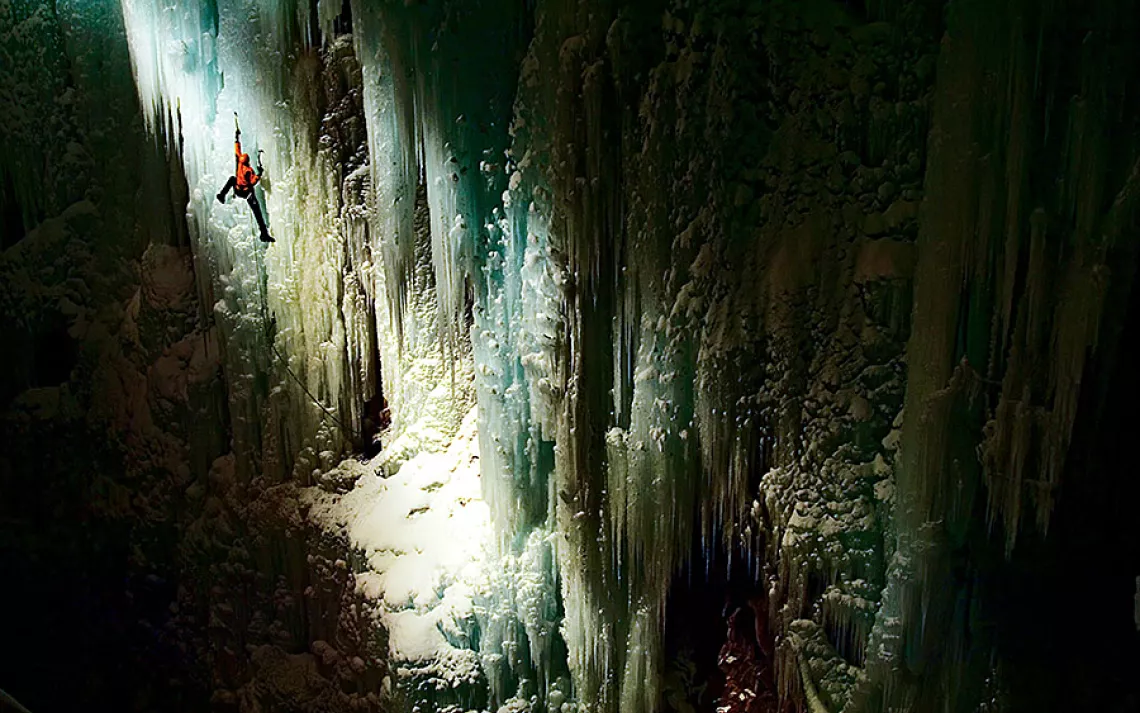
Climbing photography is a bad career choice—high risk, low pay, long hours, and no dental plan. To outsiders, the risk-to-reward ratio appears ridiculously skewed, because to get great images of world-class climbers in crazy places, shooters must be willing to join them on the wall.
Climbers at heart, these photographers know how to anticipate and capture the crux of any dramatic ascent: the fingers clutching a minuscule hold as feet scramble for purchase, the frozen moment of ropeless terror during a big free-solo assault, the bivouac flapping in the hurricane winds of a Himalayan storm.
Yet for all that climbing photographers have in common, they are as eclectic as their famously iconoclastic subjects—as evidenced by the five profiled here.
Keith Ladzinski
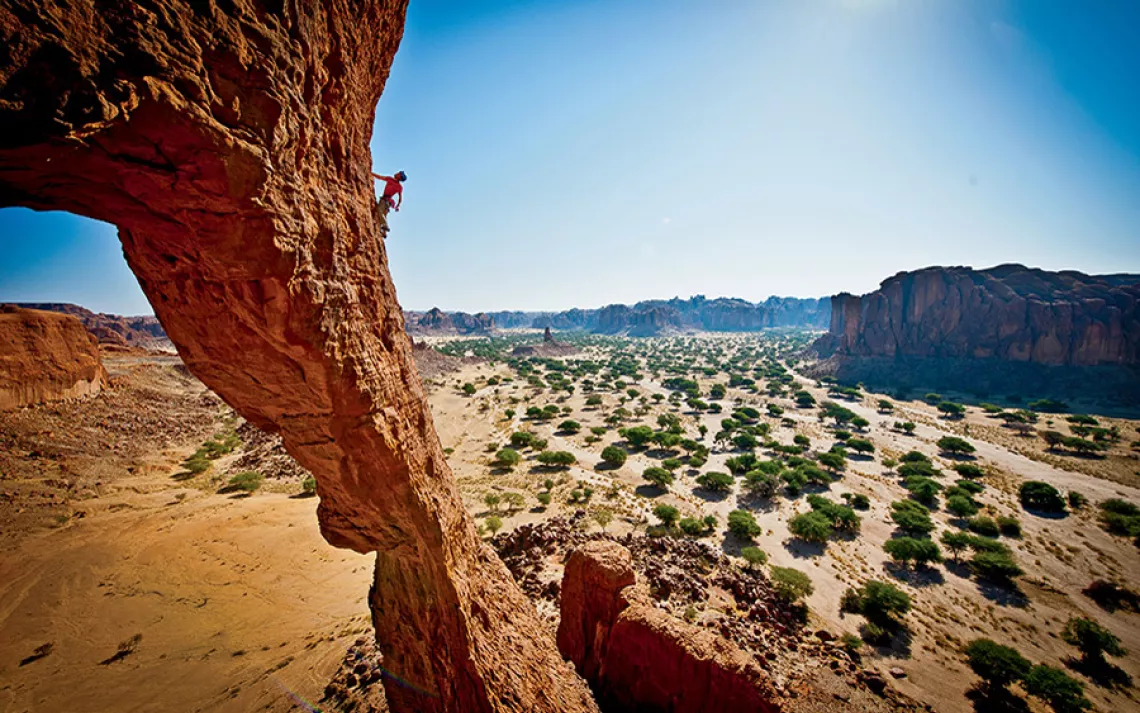
JIMMY CHIN | The Baller
"This is James Pearson making the sketchy first ascent of the Arch of Bishekele in Chad's Ennedi Desert. Besides the challenges of a remote location and technical rigging, I had to deal with extreme heat, sandstorms, and knife-wielding bandits before I got this shot."—Jimmy Chin
Jimmy Chin's career-changing moment came in 1999, after an ascent of Yosemite's El Capitan. He'd been living out of his beat-up Subaru for seven years, traversing the States to feed his climbing and skiing jones. On the wall, he used his climbing partner's camera to take some pictures, which the friend later sold for him to outdoor gear manufacturer Mountain Hardwear for $500. He couldn't believe it. "I realized if I sold 12 of those a year, I'd be living large," recalls Chin, a sinewy 38-year-old with a neat ponytail of raven hair.
Fast-forward to 2012. Chin's dirtbag days are far behind him, and now he's a high-profile, sponsored climber as well as one of the sport's most sought-after photographers. He's almost certainly the only person to both shoot a cover photo forNational Geographic and appear on the cover of Outside as an athlete.
From the Sahara to the Himalayas, Chin performs the dangerous balancing act of documenting the action and staying alive. Last winter, he survived a 2,000-foot avalanche ride in the Teton backcountry while shooting some pro snowboarders. "Trying to be creative under duress is the challenge I thrive on," he says. "I'm constantly assessing when I can shoot and when to focus on the climbing—when it's time to put the camera down and deal."
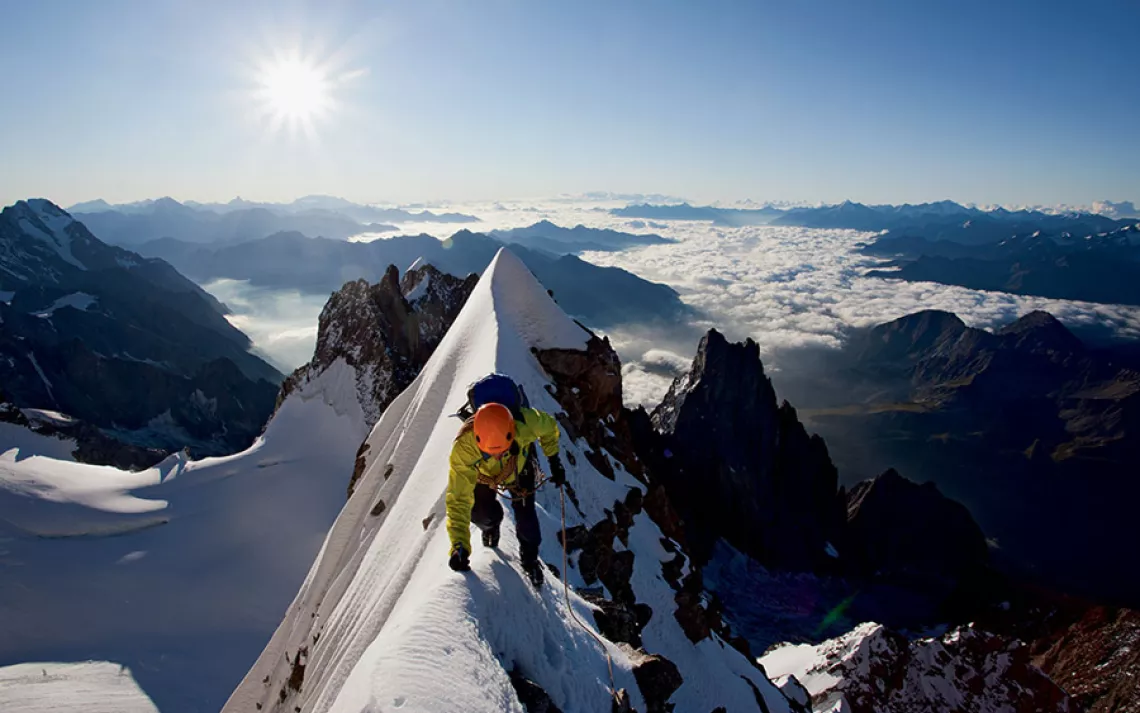
JONATHAN GRIFFITH | Storm Chaser
"I'd been waiting for years to shoot photos on the Innominata Ridge. It's a stunning knife edge that splits the immense south face of Mont Blanc, the tallest peak in Europe. I got this photo at sunrise as my partner, Ally Swinton, climbed along the terribly exposed ridge."—Jonathan Griffith
British photographer and alpinist Jonathan Griffith, 28, has lived in Chamonix, France—the birthplace of European alpinism—for the past seven years. He's known for capturing images there, and in places like Denali and Patagonia, during narrow weather windows that call for climbers to carry little and move fast.
"The whole camera setup doubles my pack weight," Griffith says. "It's like carrying 84 ounces of water that you can never drink; a sleeping bag, pad, and bivy bag that you can never sleep in; and food for three days that you can never eat."
During a recent expedition to Patagonia, Griffith and his climbing partner, Will Sim, were trying to make the second ascent of a route on Cerro Piergiorgio when the forecasted window of clear weather was a scant 24 hours. As they neared the summit, the storm smashed down on them, unleashing hurricane-force winds. "I knew it was time to go," Griffith says, "but I couldn't stop shooting."
The pair made it safely down from the summit, as did Griffith's trusty camera. "To be honest, I can't imagine a camera kit getting more used and abused than mine does," he says. "But somehow it makes it back down ready for the next battering. A bit like its owner, I guess."
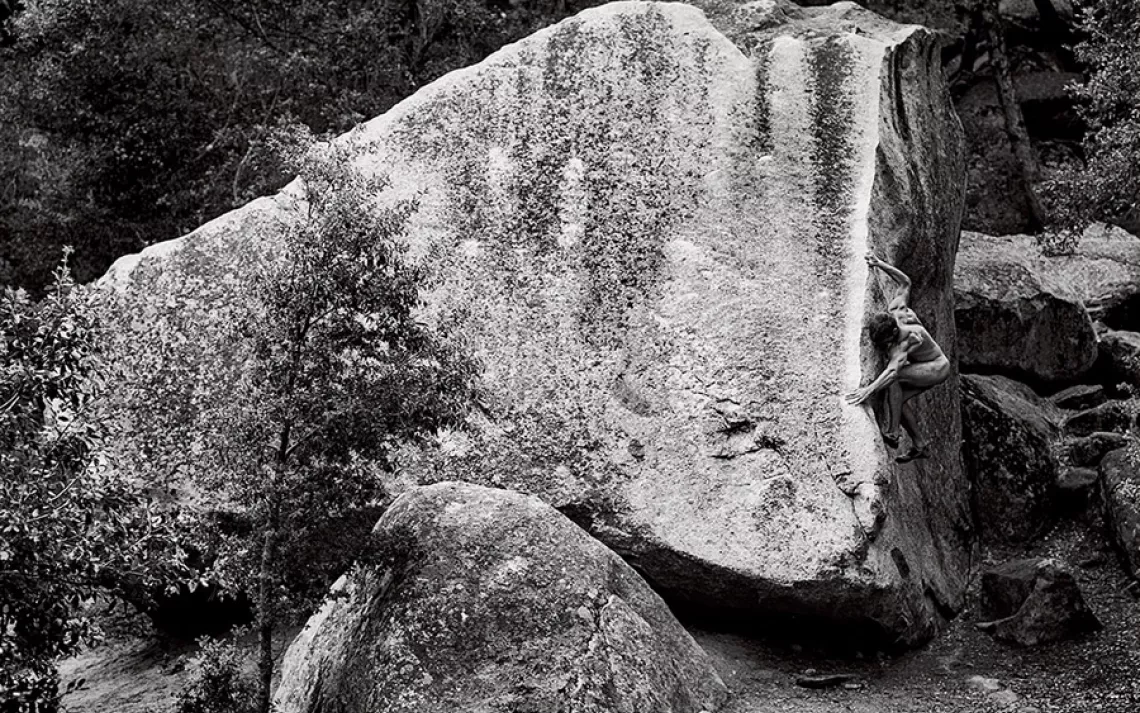
DEAN FIDELMAN | The Nude Dude
"I made this photograph in Yosemite for a Stone Nudes men's calendar. Lookouts had to be used because the boulder is near a major tourist trail. The photos were artistically successful, but low sales forced me to discontinue the men's calendar." —Dean Fidelman
"Hey, I'm not complaining," says Dean Fidelman, a 56-year-old self-described hippie who turns heads with his black-and-white images of women (and sometimes men) climbing and bouldering in the nude. "Climbing and naked women—it's pretty cool."
Both climbing and cameras started for Fidelman in high school when he took a photo course taught by a Sierra Club member and one of his assignments was to take a climbing picture. "I shot a girl bouldering and thought it was cool how her body reinterpreted the landscape for me." In the early 1970s he began taking photos in Yosemite and Joshua Tree as a member of the Stonemasters, an elite crew of vagabond climbers who lived on nickels a day and gave birth to the American rock-climbing culture.
He still shoots his nudes exclusively with black-and-white Kodak Tri-X film on a trusted 6x7 Pentax with no tripod or supplemental lighting. He's been producing his annual Stone Nudes wall calendar since 1999 and says it's essentially a money-losing enterprise. As for how he first persuaded female climbers to disrobe and pose, Fidelman says, "My landscape skills weren't that good, but my people skills were."
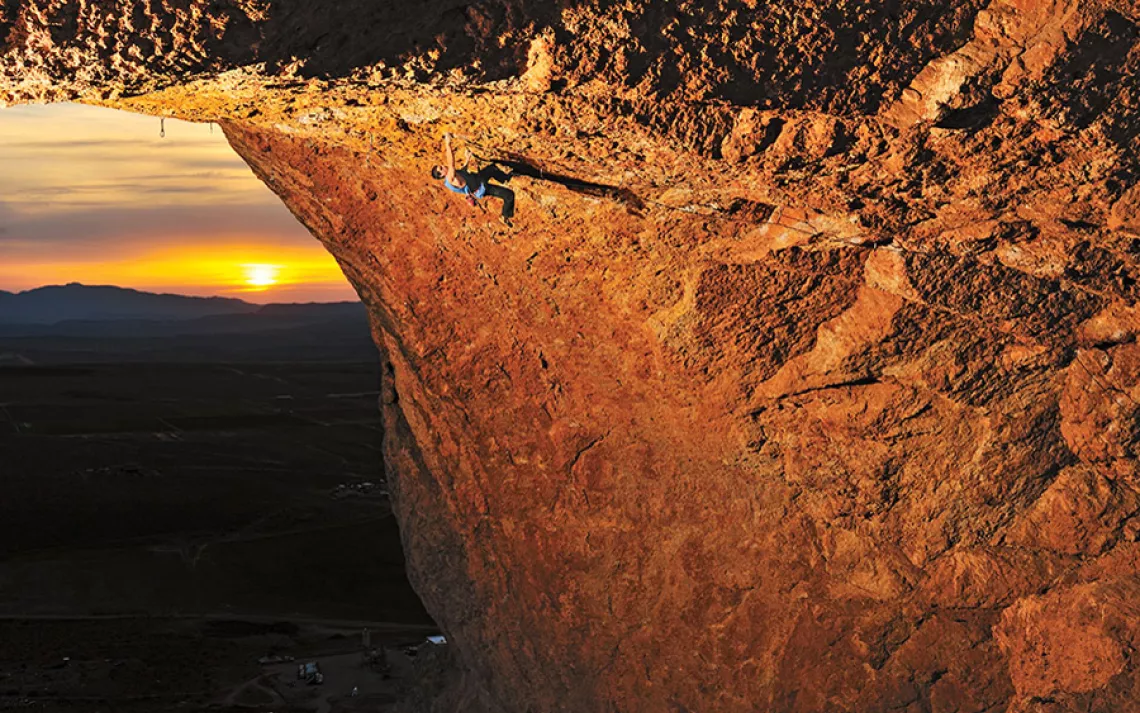
KEITH LADZINSKI | The Flash Master
"To get this photo of Joe Kinder climbing in Utah's Hurricave, my friend Seth Giles helped me haul up and place all the lighting equipment, which took about five hard hours."—Keith Ladzinski
"I was all about the cheap," Keith Ladzinski says of his first camera. "I used some lousy $200 income tax check and bought the camera from a pawnshop." Eventually he picked up some strobes too and set out to shoot his friends skateboarding around the streets of Colorado Springs and Fort Collins, Colorado.
After a couple of years of shadowing other skate photographers, Ladzinski lucked into his first official adventure assignment: shooting an ascent of Wyoming's Devil's Tower for a local magazine. "The photos were crap," he recalls. "Just butt shots and top-rope shots." The editors, however, loved them.
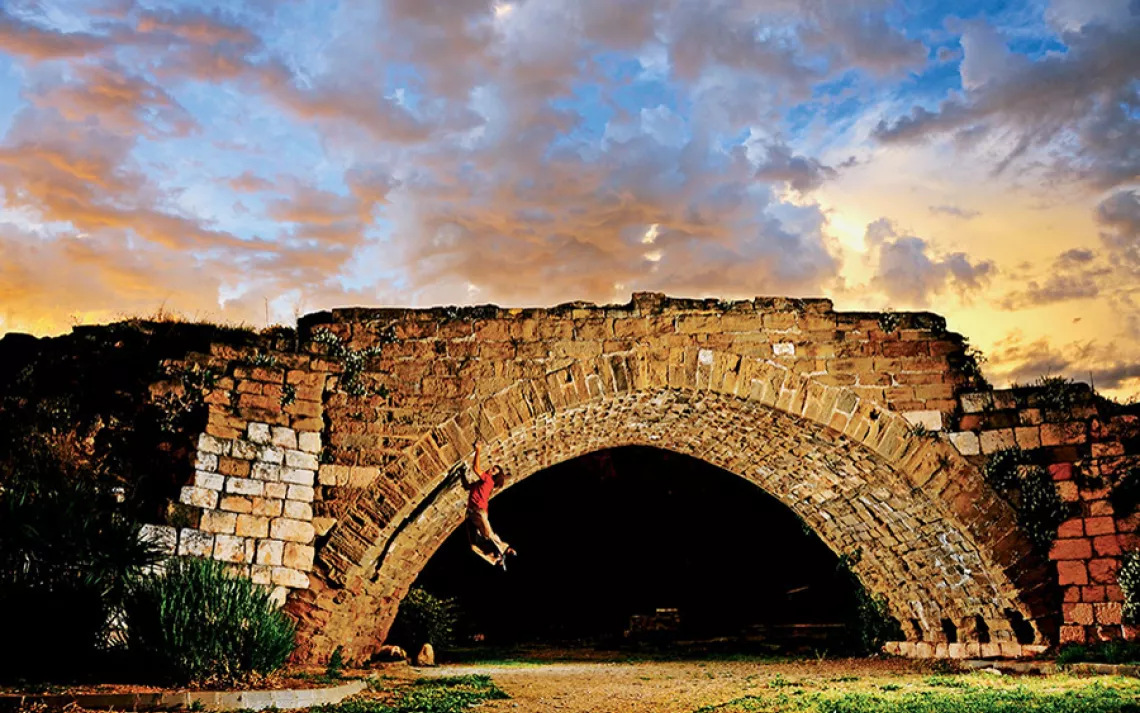
KEITH LADZINSKI | The Flash Master
"While driving back from a day of climbing with Chris Sharma, one of the world's best rock climbers, I spotted this old bridge near his home in Spain. Chris and I were pretty fired up when the photo ended up being used in a climbing-shoe ad." —Keith Ladzinski
Not long after, Ladzinski teamed up with a friend to shoot bouldering and urban climbing on the underside of a bridge. "I shot it up with the strobes, just like with the skate shots," he says. Climbing companies and magazines gobbled up Ladzinski's flash-heavy images, the likes of which the sport had never seen. In 2006, an ice-climbing photo of his made it onto the front page of the New York Times.
Ladzinski's peerless success with remote strobes is the result of countless hours of installing lights and taking test shots. "I now know exactly how to rig everything so the light is just how I want it," says the 35-year-old photographer. "I don't have problems with flashes falling out of trees anymore, but I'll still spend five hours on one shot. It's never easy."
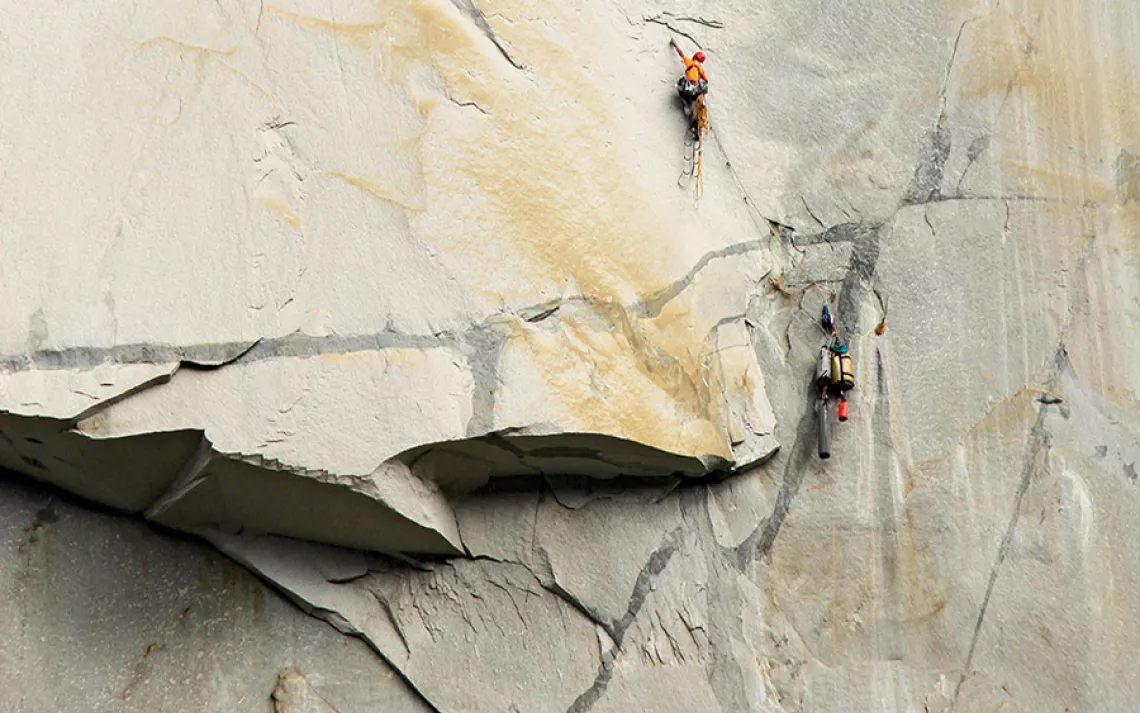
TOM EVANS | The Bridge Sergeant
"Marek Raganowicz is a well-known Polish solo climber, and I shot this photo as he climbed past the Nine O'Clock Roof on El Capitan's Zenyatta Mondatta. This was his sixth solo on El Cap, done just after his 50th birthday." —Tom Evans
"El Capitan had the climbers and faced in the right direction," explains Tom Evans of his photographic obsession. "I've always enjoyed looking at the Great Rock, so it was a natural choice." Since 1996, the retired schoolteacher, military veteran, and former big-wall climber has spent six to eight hours a day for several months each year on Yosemite's El Cap Bridge, photographing climbers scaling the 3,000-foot wall.
From this position, Evans, 67, has documented epic failures, historic speed ascents, and daring helicopter rescues. "Yosemite's search-and-rescue guys are among the best in the world," he says.
Evans posts his extraordinary images and climber updates each night on his ElCap Report, a blog popular among "cubicle pukes"—his term for desk-shackled adventurers. "Pay attention, Pukes," he writes. "Clear your agenda, and saddle up, because you are riding with Old Tom, on a journey to the very soul of the Big Stone. You're going to send with the senders and bail with the bailers."
Although Evans makes no profit from his exhaustive effort, he does receive occasional PayPal contributions through his blog and shares frequent hand-delivered six-packs of King Cobra tallboys with appreciative fans on the bridge.
 The Magazine of The Sierra Club
The Magazine of The Sierra Club


